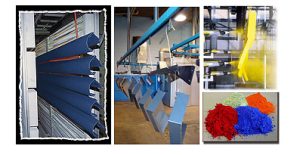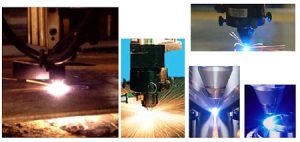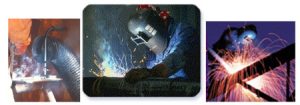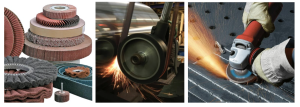 Surface treatments that project abrasive particles at high speed onto the surface to be treated. Typically used as preparation for subsequent applications of protective coatings or as a cleanup of contaminants or other residues.
The specific processes are e.g.:
Surface treatments that project abrasive particles at high speed onto the surface to be treated. Typically used as preparation for subsequent applications of protective coatings or as a cleanup of contaminants or other residues.
The specific processes are e.g.:
 Process of applying powders to the surface of pieces to make them resistant to various external agents. By inducing electrostatic charges, the powder is directed towards the piece, reducing the particles suspended in the air to a minimum. The coating powders vary considerably according to the results to be obtained. They are generally based on epoxy, acrylic, polyester, polyurethane or nylon.
Filtration must therefore take into account the following specific parameters:
Process of applying powders to the surface of pieces to make them resistant to various external agents. By inducing electrostatic charges, the powder is directed towards the piece, reducing the particles suspended in the air to a minimum. The coating powders vary considerably according to the results to be obtained. They are generally based on epoxy, acrylic, polyester, polyurethane or nylon.
Filtration must therefore take into account the following specific parameters:
 Metal cutting technologies based on different operating principles. Laser cutting uses a very intense beam of light to cut the material, the plasma creates an arc between the electrode and the treated piece creating a flow of plasma at temperatures even over 20,000°C. Oxyfuel, on the other hand, uses an acetylene flame and a jet of pure oxygen.
The filtration of these processes must therefore take into account the following specific parameters:
Metal cutting technologies based on different operating principles. Laser cutting uses a very intense beam of light to cut the material, the plasma creates an arc between the electrode and the treated piece creating a flow of plasma at temperatures even over 20,000°C. Oxyfuel, on the other hand, uses an acetylene flame and a jet of pure oxygen.
The filtration of these processes must therefore take into account the following specific parameters:
 Process that creates connections between metal pieces by heat and/or pressure, with or without the addition of another filler metal. The smelting area must be protected from oxidation phenomena, and the molten metal must be purified of slag.
The filtration of these processes must therefore take into account the following specific parameters:
Process that creates connections between metal pieces by heat and/or pressure, with or without the addition of another filler metal. The smelting area must be protected from oxidation phenomena, and the molten metal must be purified of slag.
The filtration of these processes must therefore take into account the following specific parameters:
 Deburring: eliminates burrs from molded or extruded pieces by sandblasting or mechanical tools of various kinds.
Grinding: process of forming materials, usually on glass and metals, in which rotary tools are mostly used.
The filtration of these processes must therefore take into account the following specific parameters:
Deburring: eliminates burrs from molded or extruded pieces by sandblasting or mechanical tools of various kinds.
Grinding: process of forming materials, usually on glass and metals, in which rotary tools are mostly used.
The filtration of these processes must therefore take into account the following specific parameters:
 Surface finishing processes in which rotary tools with specific discs are usually used according to the surface structure to be obtained.
The filtration of these processes must therefore take into account the following specific parameters:
Surface finishing processes in which rotary tools with specific discs are usually used according to the surface structure to be obtained.
The filtration of these processes must therefore take into account the following specific parameters:
 Metallization groups various applications for the deposition of a thin film of metals, alloys, ceramics, plastics and composite materials on a support material.
Filtration must take into account the following specific parameters:
Metallization groups various applications for the deposition of a thin film of metals, alloys, ceramics, plastics and composite materials on a support material.
Filtration must take into account the following specific parameters:
 Used for the autonomous production of electricity.
Large quantities of air are needed to converge in the combustion chamber and problems of various kinds can arise if it does not have the pre-established composition of particulate matter and humidity, all with serious effects on the turbine's performance and management costs.
The filtration of these processes must therefore take into account the following specific parameters:
Used for the autonomous production of electricity.
Large quantities of air are needed to converge in the combustion chamber and problems of various kinds can arise if it does not have the pre-established composition of particulate matter and humidity, all with serious effects on the turbine's performance and management costs.
The filtration of these processes must therefore take into account the following specific parameters:
 Various types of mechanical tools are used in the cutting and processing of natural stone, marble and ceramics, often using water as a cutting or cooling medium.
The filtration of these processes must therefore take into account the following specific parameters:
Various types of mechanical tools are used in the cutting and processing of natural stone, marble and ceramics, often using water as a cutting or cooling medium.
The filtration of these processes must therefore take into account the following specific parameters:
 Thermoplastics group together a wide range of polymers that have similar basic characteristics. These are then modified to acquire specific characteristics according to the technical requirements of the finished product.
Filtration of these processes must therefore take into account the following specific parameters:
Thermoplastics group together a wide range of polymers that have similar basic characteristics. These are then modified to acquire specific characteristics according to the technical requirements of the finished product.
Filtration of these processes must therefore take into account the following specific parameters:
 Used in a multitude of applications, to transfer powdery products without dispersion from the point of withdrawal to a container, molding unit, dosing unit or packaging unit. Other applications are transfer to production machines or in dry lubrication.
The filtration of these processes must therefore take into account the following specific parameters:
Used in a multitude of applications, to transfer powdery products without dispersion from the point of withdrawal to a container, molding unit, dosing unit or packaging unit. Other applications are transfer to production machines or in dry lubrication.
The filtration of these processes must therefore take into account the following specific parameters:
 Specific equipment for dry vacuuming of solids, liquids, sludge and dust of various origins according to specific needs (rubble, debris, sand, asbestos, blast furnace dust, etc.).
Once the contaminants have accumulated, the vehicle transfers them directly to disposal.
The filter media used must therefore ensure that:
Specific equipment for dry vacuuming of solids, liquids, sludge and dust of various origins according to specific needs (rubble, debris, sand, asbestos, blast furnace dust, etc.).
Once the contaminants have accumulated, the vehicle transfers them directly to disposal.
The filter media used must therefore ensure that:
 Silo venting takes place during filling; the air comes out without dragging the product. Filtration also takes place in the reverse direction - during emptying - to protect the product from external contamination.
Filtration must therefore take into account the following specific parameters:
Silo venting takes place during filling; the air comes out without dragging the product. Filtration also takes place in the reverse direction - during emptying - to protect the product from external contamination.
Filtration must therefore take into account the following specific parameters:
 Application of (solvent or) water-based paint on artifacts of various kinds.
The filter media must guarantee:
Application of (solvent or) water-based paint on artifacts of various kinds.
The filter media must guarantee:
 Systems used in many different industrial processes, in the fields of chemistry, pharmaceuticals, food, metallurgical, plastic and many others.
The filtration must therefore take into account the following specific parameters
Systems used in many different industrial processes, in the fields of chemistry, pharmaceuticals, food, metallurgical, plastic and many others.
The filtration must therefore take into account the following specific parameters
 Liquid filtration covers a vast field of very different applications.
The filtration must therefore take into account the following specific parameters
Liquid filtration covers a vast field of very different applications.
The filtration must therefore take into account the following specific parameters